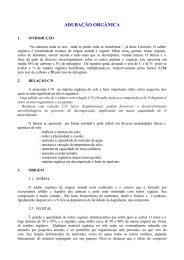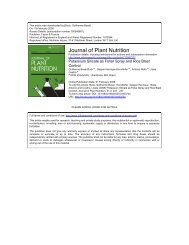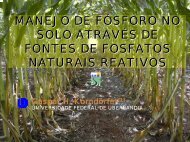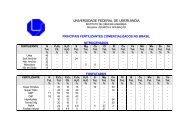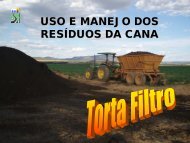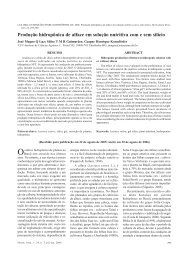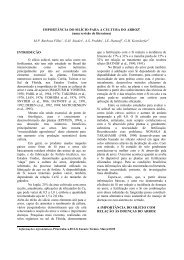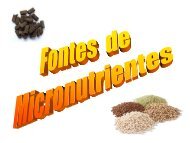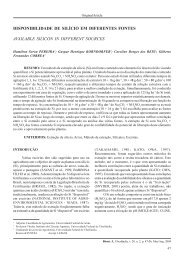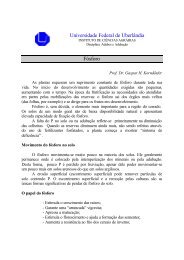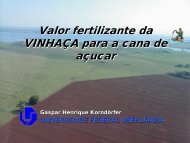Efficiency of Calcium Silicate and Carbonate in Soybean Disease ...
Efficiency of Calcium Silicate and Carbonate in Soybean Disease ...
Efficiency of Calcium Silicate and Carbonate in Soybean Disease ...
- No tags were found...
You also want an ePaper? Increase the reach of your titles
YUMPU automatically turns print PDFs into web optimized ePapers that Google loves.
2052 A. Nolla et al.selected due to its low concentration <strong>of</strong> available Si (s<strong>and</strong>y texture) (Beckwith<strong>and</strong> Reeve, 1963) <strong>and</strong>, consequently, greater probability <strong>of</strong> plant response tosoil application <strong>of</strong> that element.Due to the naturally low fertility <strong>of</strong> the soil collected, soil fertilization wasperformed by add<strong>in</strong>g, with the aid <strong>of</strong> a concrete mixer, the equivalent <strong>of</strong> 400 kgP 2 O 5 ha −1 , 400 kg K 2 Oha −1 , 240 kg magnesium (Mg) ha −1 , <strong>and</strong> 100 kg <strong>of</strong> amicronutrient fertilizer <strong>in</strong> the form <strong>of</strong> frited trace element (FTE) [9% z<strong>in</strong>c (Zn),1.8% boron (B), 2% manganese (Mn), 0.8% copper (Cu), 0.1% molybdenum(Mo), <strong>and</strong> 3% iron (Fe)]. Subsequently, 200 kg lots <strong>of</strong> the soil were placed <strong>in</strong>250 L drums 54 cm <strong>in</strong> diameter × 83 cm <strong>in</strong> height. The drums were placed<strong>in</strong> an open <strong>and</strong> fenced area over crushed rocks to avoid contam<strong>in</strong>ation <strong>of</strong> thesoil <strong>in</strong> the columns. Excess water <strong>in</strong> the columns was avoided by punch<strong>in</strong>g five1.3 cm diameter holes <strong>in</strong>to the upper <strong>and</strong> lower ends <strong>of</strong> the side <strong>of</strong> the drum.The equivalent <strong>of</strong> 0, 1500, 3000 (lim<strong>in</strong>g requirement), 6000, <strong>and</strong>12,000 kg ha −1 calcium carbonate (99% CaCO 3 )orcalcium silicate, providedby the company Rockfibras do Brasil (18% CaO <strong>and</strong> 40% SiO 2 ), was appliedto the column surface (without <strong>in</strong>corporation), <strong>in</strong> a r<strong>and</strong>omized block designwith four repetitions, as a 2 × 5factorial experiment (two materials <strong>and</strong> fivedoses). The soil columns were left fallow for 15 d, then irrigated with 12 L <strong>of</strong>water immediately after the application <strong>of</strong> the corrective materials to allow fora better reactivity with the soil.The soybean cultivar used was BRS/MG-68 ‘Vencedora,’ which has a determ<strong>in</strong>ategrowth habit; average plant height <strong>of</strong> 80 cm; average <strong>in</strong>sertion height <strong>of</strong>the first pod <strong>of</strong> 15 cm; purple-colored flowers; brown pubescence; black hilum;good resistance to stalk<strong>in</strong>g; good seed quality <strong>and</strong> resistance to frog’s eye spot(Cercospora soj<strong>in</strong>a), bacterial pustule (Xanthomonas campestris pv glyc<strong>in</strong>ea),bacterial blight (Pseudomonas syr<strong>in</strong>gae pv glyc<strong>in</strong>ea), powdery mildew (Microsphaeradiffusa), <strong>and</strong> stem canker (Phomopsis phaseoli f.sp. meridionalis).This cultivar is also tolerant to the gall nematodes (Meloydog<strong>in</strong>e <strong>in</strong>cognita<strong>and</strong> M. javanica); however, it is susceptible to the cyst nematode (Heteroderaglyc<strong>in</strong>es) (EMBRAPA, 2004).Twenty Bradyrhizobium japonicum pre-<strong>in</strong>oculated seeds were planted onDecember 23, 2003 <strong>in</strong> the drums, <strong>in</strong> two rows spaced at 0.25 cm, <strong>and</strong> wereth<strong>in</strong>ned to five plants per row. <strong>Soybean</strong> seeds were not fungicide treated, so diseasedevelopment could be monitored dur<strong>in</strong>g the culture cycle. The experimentsimulated direct plant<strong>in</strong>g <strong>and</strong> culture rotation with sugar cane (Saccharum <strong>of</strong>fic<strong>in</strong>arum);therefore, the equivalent <strong>of</strong> 10 mg ha −1 sugar cane straw mulch wasapplied to the surface <strong>of</strong> the drums. The soil moisture was ma<strong>in</strong>ta<strong>in</strong>ed throughra<strong>in</strong>fall or by irrigation (with tap water) dur<strong>in</strong>g the dry season.Only an <strong>in</strong>secticide was used for pest (Nezara viridula) control dur<strong>in</strong>gthe culture cycle. Evaluation for disease (Peronospora manshurica—Downymildew, Cercospora soj<strong>in</strong>a—frog’s eye spot, <strong>and</strong> Phakopsora pachyrhizi—Asian rust) was performed at 47, 66, <strong>and</strong> 79 d after plant seed<strong>in</strong>g. Three plantswere selected per drum, <strong>and</strong> disease was evaluated us<strong>in</strong>g the Horsfall <strong>and</strong> Barrat



